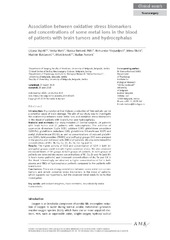Приказ основних података о документу
Association between oxidative stress biomarkers and concentrations of some metal ions in the blood of patients with brain tumors and hydrocephalus
| dc.creator | Vujotić, Ljiljana | |
| dc.creator | Matić, Siniša | |
| dc.creator | Borković-Mitić, Slavica S. | |
| dc.creator | Stojsavljević, Aleksandar | |
| dc.creator | Mutić, Jelena | |
| dc.creator | Baščarević, Vladimir | |
| dc.creator | Joković, Miloš | |
| dc.creator | Pavlović, Slađan Z. | |
| dc.date.accessioned | 2020-07-09T11:24:10Z | |
| dc.date.available | 2020-07-09T11:24:10Z | |
| dc.date.issued | 2020 | |
| dc.identifier.issn | 1734-1922, 1896-9151 | |
| dc.identifier.uri | https://cherry.chem.bg.ac.rs/handle/123456789/3982 | |
| dc.description.abstract | Introduction: Any substance that induces production of free radicals can be a potential cause of brain damage. The aim of our study was to investigate the relationship between some metal ions and oxidative stress biomarkers in the blood of patients with brain tumor and hydrocephalus. Material and methods: Our study included 27 control subjects, 24 patients with brain tumor and 21 patients with hydrocephalus. The activities of superoxide dismutase (CuZn SOD), catalase (CAT), glutathione peroxidase (GSH-Px), glutathione reductase (GR), glutathione S-transferase (GST) and acetyl cholinesterase (AChE), as well as concentrations of reduced glutathione (GSH), lipid peroxides (TBARS) and sulfhydryl groups (SH) were analyzed in the plasma and red blood cells (RBCs) of patients. We also determined the concentrations of Mn, Ni, Co, Cu, Zn, As, Se, Cd, Hg and Fe. Results: The higher activity of SOD and concentration of GSH in both investigated groups could indicate higher oxidative stress. We also observed decreased levels of SH groups in both groups of patients. In both groups of patients we detected decreased concentrations of Ni, Co, Zn and Fe (and Mn in brain tumor patients) and increased concentrations of As, Se and Cd in the blood. Interestingly, we observed a higher concentration of Cd in both plasma and RBCs of hydrocephalus patients compared to the patients with brain tumor. Conclusions: There are strong correlations between some metal ion concentrations and certain oxidative stress biomarkers in the blood of patients, which supports our hypothesis, but the observed trend needs to be further investigated. | |
| dc.publisher | Termedia Publishing House | |
| dc.rights | openAccess | |
| dc.rights.uri | https://creativecommons.org/licenses/by-nc-sa/4.0/ | |
| dc.source | Archives of Medical Science | |
| dc.subject | Antioxidant enzymes | |
| dc.subject | Neurotoxicity redox homeostasis | |
| dc.subject | Trace elements | |
| dc.title | Association between oxidative stress biomarkers and concentrations of some metal ions in the blood of patients with brain tumors and hydrocephalus | |
| dc.type | article | |
| dc.rights.license | BY-NC-SA | |
| dcterms.abstract | Стојсављевић, Aлександар; Мутић, Јелена; Матић, Синиша; Борковић-Митић, Славица; Башчаревић, Владимир; Јоковић, Милош; Вујотић, Љиљана; Павловић, Слађан; | |
| dc.citation.volume | 16 | |
| dc.citation.issue | 4 | |
| dc.citation.spage | 811 | |
| dc.citation.epage | 819 | |
| dc.identifier.wos | 000539503400011 | |
| dc.identifier.doi | 10.5114/aoms.2019.87409 | |
| dc.citation.rank | M21~ | |
| dc.type.version | publishedVersion | |
| dc.identifier.scopus | 2-s2.0-85086326874 | |
| dc.identifier.fulltext | https://cherry.chem.bg.ac.rs/bitstream/id/17275/Association_between_oxidative_pub_2020.pdf |


